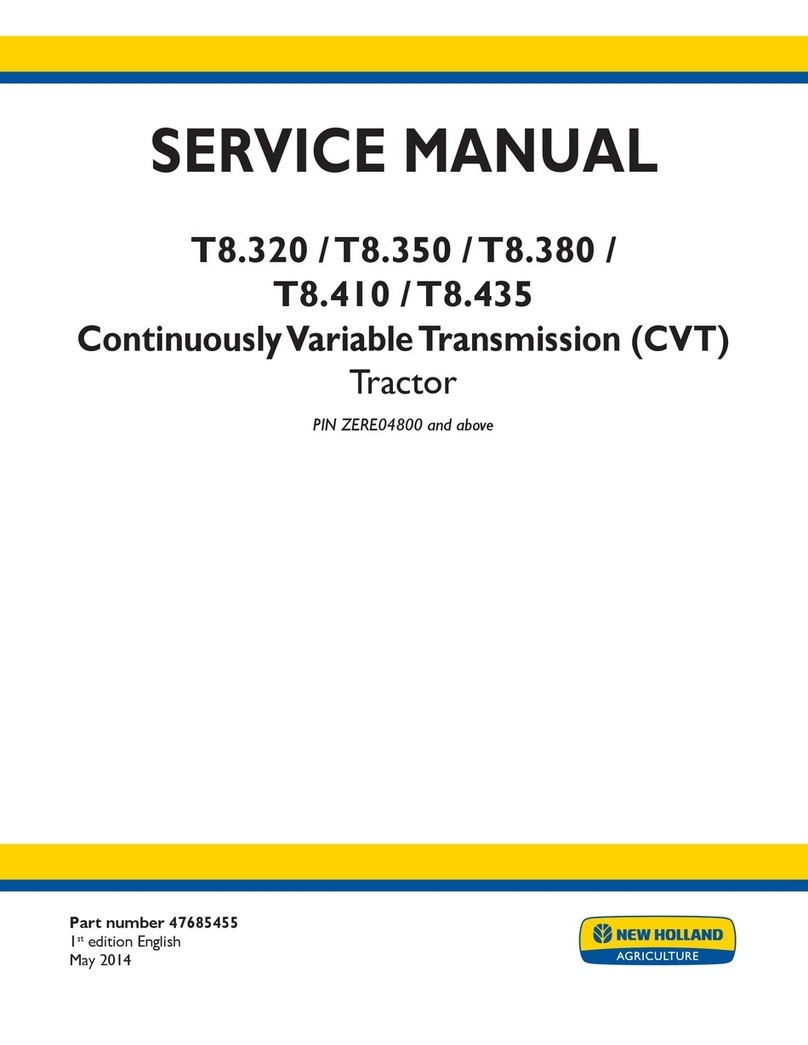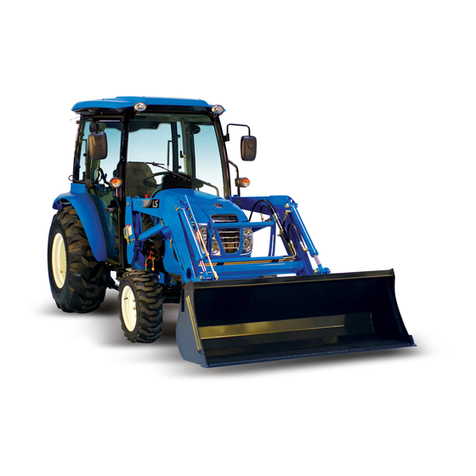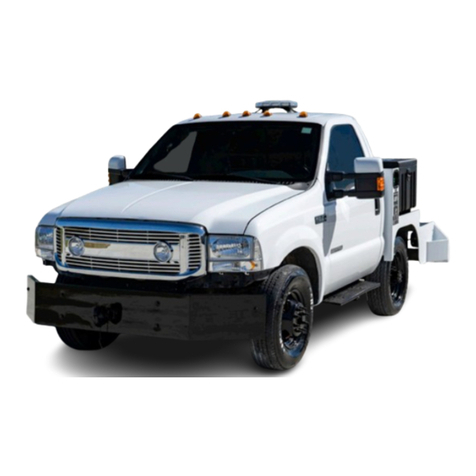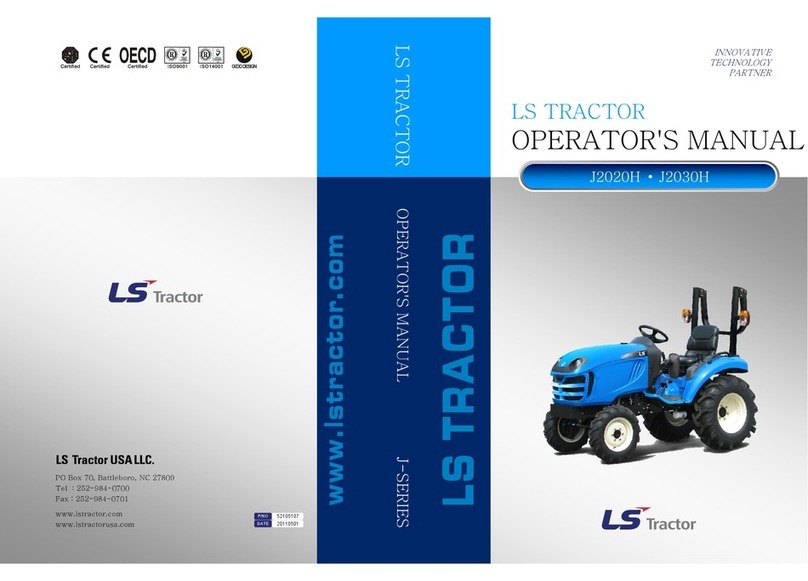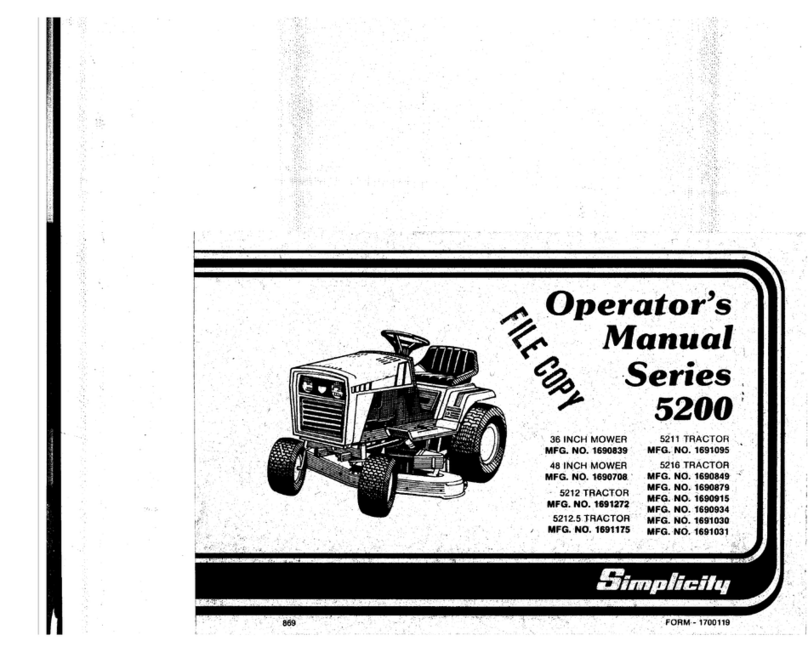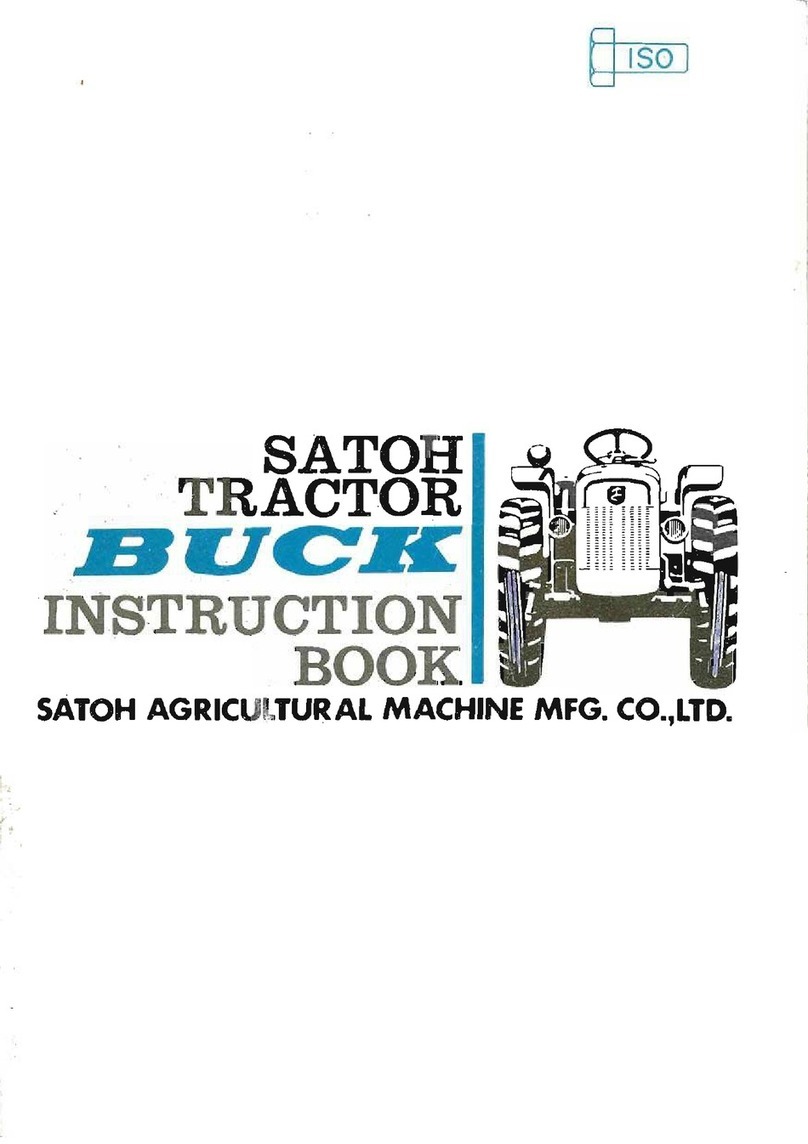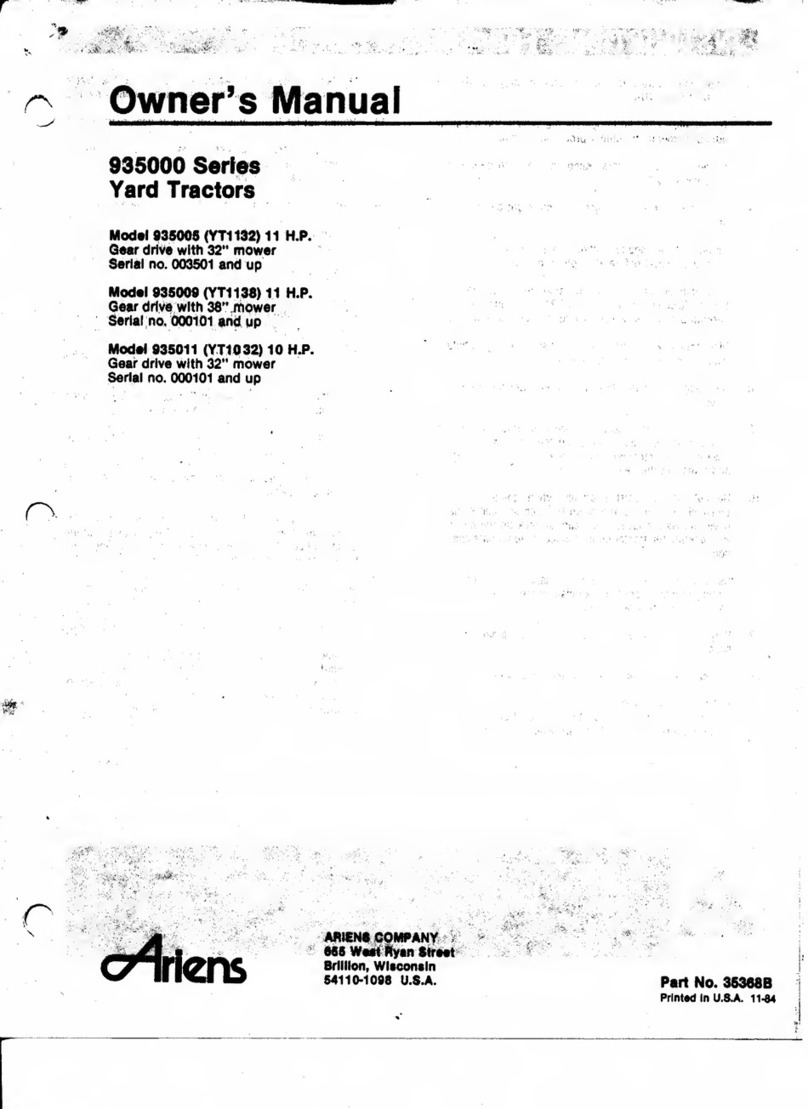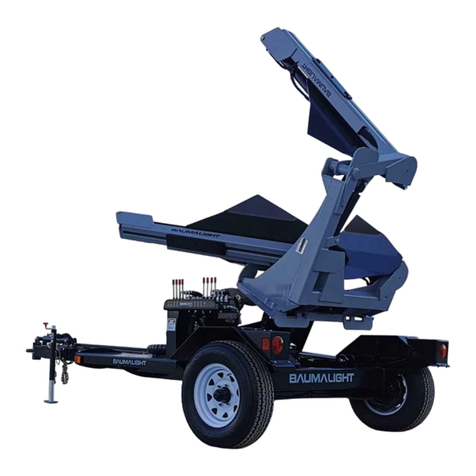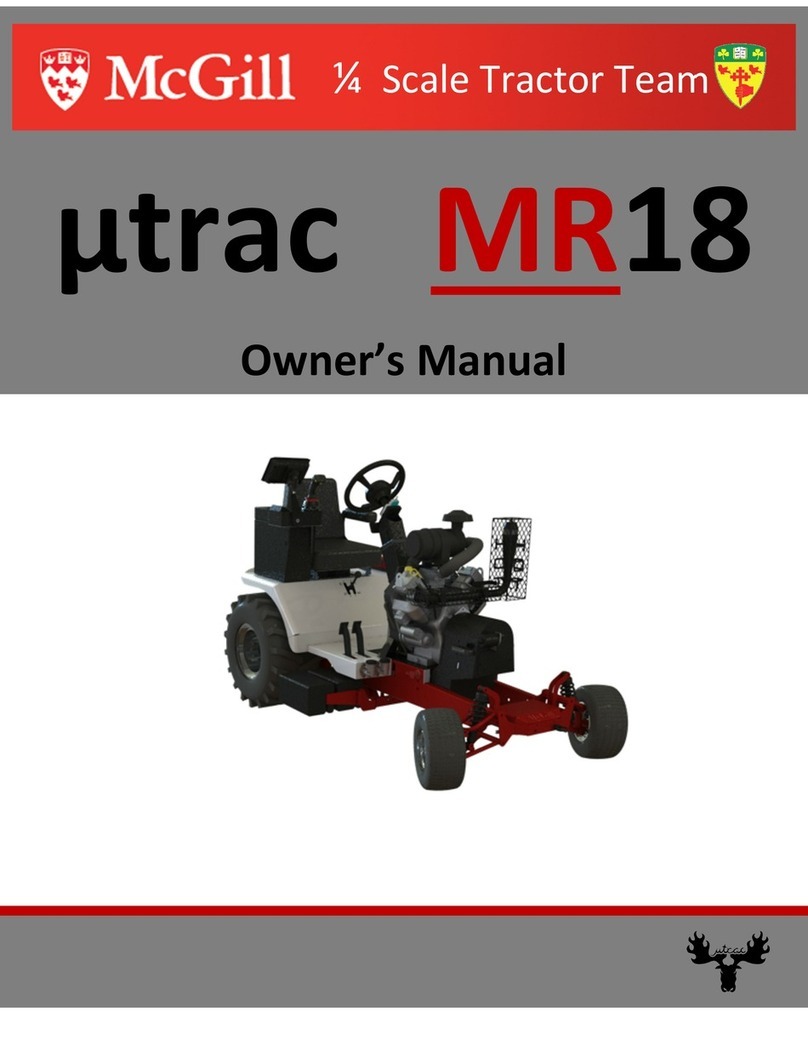Swiss-Trac H Series User manual

Instruction Manual
English, Version 5.2
Model SWT-1 Model SWT-2
The Swiss-Trac tractor for manual wheelchairs mod. SWT-1, SWT-1S, SWT-1HD and SWT-2
described in this instruction manual comply with the Directive 93/42/EEC and
correspond to Swiss regulations for medical products (MepV).
Medical appliance number Germany: 18.99.04.0020
Information for specialist dealers: During the first commissioning and the annual
maintenance stipulated by the manufacturer, the proof of maintenance on page
30 has to be stamped.
More information online: On our website you can find videos for the handling of the
Swiss-Trac, documentation on the available accessories, addresses of our specialist
dealers and much more:
www.swisstrac.ch
This instruction manual applies to the following Swiss-Trac models:
SWT-1 from series H onwards, SWT-1HD, SWT-1S, and SWT-2.


Dear customer,
We appreciate that you have chosen a Swiss-Trac tractor for manual wheelchairs.
We thank you for your trust in us.
Your manual wheelchair and the Swiss-Trac make for a powerful combination. The
high mobility, plus the ease of use and transport deliver the highest possible
independence and flexibility.
We will continue to fulfil the wish of wheelchair users for more independence and
improve their mobility with the Swiss-Trac.
Before the first use, please read this instruction manual carefully. Information on the
use of the battery charger is provided in the corresponding instruction manual.
Ignoring the instruction manual, as well as improper maintenance or repair will
endanger your safety and will result in the expiry of the warranty as well as the
product liability.
Please also observe the safety instructions in the instruction manual of your
wheelchair.
On our website you can find videos for the handling of the Swiss-Trac, documenta-
tion on the available accessories, addresses of our specialist dealers and much
more:
www.swisstrac.ch
We wish you a safe journey!
Josef Jakober, Ing. FH
ATEC Ingenieurbüro AG
Breitenstrasse 1
CH-6403 Küssnacht a. R.
Schweiz


Safety Safety Instructions 4
Overview Product Description 6
Checking the Bracket on the Wheelchair 7
Driving Control Panel and Handling 8
Attach and Detach 9
On-Road and O-Road Driving 10
Brakes 10
Turns and Turning Radius 11
Passing Ledges and Obstacles 12
Driving Assistance 14
Batteries Batteries, Battery Display 15
Range, Charging the Batteries 16
Maintenance when Not in Use 17
Transport In the Car 18
In Public Transport, On Planes 20
Maintenance Maintenance and Cleaning 21
Tyre Equipment 22
Headlight 23
Reuse and Disposal 23
Annex Technical Data 24
Optical and Acoustic Error Display 26
Troubleshooting 27
Warranty, Liability and CE Conformity Declaration 28
Accessories 29
Proof of Maintenance 30
Content

4
Safety Instructions
The Swiss-Trac is a high-performance tractor for manual wheelchairs. Please comply
with the following instructions to guarantee operating safety:
Trailing Load and Gradability
Never overload your Swiss-Trac or use it for purposes other than those intended.
The maximum trailing load is dependent on the model (see p. 24, "Technical
Data") and must not be exceeded under any circumstances. The maximum gradabil-
ity depends on the model and the ground surface. This value can decrease drasti-
cally with wet conditions or snow.
If the incline is too steep or the trailing load too great, a beep signal is sounded and
the Swiss-Trac automatically slows down. Reduce the speed immediately using the
gas stick, otherwise the Swiss-Trac will switch off within a few seconds and must be
turned off and on again using the ignition key. Please avoid overstressing the
Swiss-Trac in this way, as its service life will be reduced.
Cross Slope
Additionally, please follow the safety instructions in the instruction manual of your
wheelchair. The maximum permissible tilt in particular depends on the lateral
stability of your wheelchair, not on the Swiss-Trac.
Do not drive on a road or a path with a steep cross slope. There is a risk of tipping
sideways.
Bracket and Wheelchair
The bracket must only be used in its original condition and after having been
correctly attached. To guarantee functional safety, please have the wheelchair’s
bracket and the Swiss-Trac checked annually.
Driving and Steering
Avoid sudden acceleration or sharp steering motions.
Braking
Do not use the handbrake while driving. It only serves for parking. The Swiss-Trac is
equipped with a very efficient motor brake, with which the combination can be
slowed down reliably at any time.
Ledges and Obstacles
Kerbs and other obstacles always have to be driven over at right angles, never
sideways. Do not try to drive over ledges higher than 13 cm. This can damage the
wheelchair.
Never drive without a proper connection to the Swiss-Trac.
Safety

5
Parking
When parking the Swiss-Trac, always remove the key and apply the handbrake.
Reflectors and Rear Lights
We recommend the installation of yellow reflectors on the spokes of the wheelchair
wheels and 2 red rear lights on the back of the wheelchair.
Road Safety and Liability
The Swiss-Trac is an auxiliary drive for wheelchairs and can be driven in pedestrian
areas at walking speed. Please follow the current traffic regulations. We recommend
taking out liability insurance.
Road Traic Approval
In Switzerland no approval test is currently required.
Germany: From 7 km/h, an operating permit is required from the relevant authorities
for road traffic. Insurance, tail lights and reflectors are also required in accordance
with the road traffic licensing regulations (StVO).
The user is responsible for the fee-based individual assessment and acquiring
insurance for the combination.
Electromagnetic Fields
Radiation from electronic equipment, such as radio equipment, portable radios or
other powerful transmission devices, generates electromagnetic fields. This can
influence the Swiss-Trac controls. If you notice unusual performance, stop and
switch off the Swiss-Trac. In certain cases, the Swiss-Trac itself can cause malfunc-
tions of electromagnetic fields. However, the use of wireless telephones and mobile
phones does not pose a problem.
Maintenance
Check the functionality of the gas stick at least once a week. Please do not drive if
the gas stick does not return exactly to neutral position due to the internal spring
resistance. Inform your specialist dealer and arrange for a repair.
Keep the Swiss-Trac and the wheelchair in dependable working order. In particular,
the brakes of the wheelchair must work flawlessly.
To guarantee functional safety, the Swiss-Trac and its bracket have to be
maintained by an authorised specialist dealer once every year. The proof of
maintenance (see p. 30) has to be updated by the specialist dealer.
Safety

6
Product Description
* Different parts for the bracket are required depending on the type of wheelchair.
** Different types of drawbars are available. Your specialist dealer will be glad to
advise you.
Where the customer has carried out the mounting of the bracket by him- /
herself, we give no guarantee and do not accept any liability.
Overview
Control Panel
Luggage Carrier
Front Wheel
Drawbar**
Rear Wheel
(Drive Wheel)
Crane Eyelet
Steering Handle Lock
Bumper
Bracket*
Lever
Handlebars
Headlight
Steering Tube

7
C D
B
E
A
Checking the Bracket on the Wheelchair
The bracket, which is mounted to the wheelchair, is necessary to attach the
Swiss-Trac to the wheelchair.
Due to the many different types of wheelchairs, assembly and adjustment of the
bracket requires expertise and experience. Therefore, the assembly must be carried
out by an authorised specialist dealer. This also applies to a change of wheelchair or
after changes to the sitting position or inclination.
The bracket is properly adjusted when only minimum effort is needed for driving
and the front wheels of the wheelchair are lifted sufficiently when passing over
ledges.
During driving, hold the handlebars loose and between 10 and 15 cm above your
thighs. The front wheels of your wheelchair should always be 1.5 – 2 cm above the
ground.
If this is not the case, request an adjustment by your specialist dealer.
→ You can easily check the adjustment
yourself with a connected Swiss-Trac
during standstill, as shown here:
Driving position
AGround – Drawbar bearing: 19 cm
B Ground – Wheelchair front wheel:
1.5 – 2 cm
Front wheels of wheelchair on the ground
C Ground – Drawbar bearing: 15 cm
D Ground – Bracket:
Straight drawbar 20 – 22 cm
Bent drawbar 25 – 28 cm
All 4 Swiss-Trac wheels on the ground
E Ground– Wheelchair front wheel:
at least 5 cm
Overview

8
Control Panel and Handling
Ignition Switch
Control Light
Battery Display
HandbrakeSpring for handbrake
Gas Stick
Light Switch
Ignition
Insert the key into the ignition switch on the control panel and turn it to the right.
After turning, the control light ignites and signals that Swiss-Trac is ready to be driven.
→ Do not operate the gas stick during startup / ignition. Otherwise, the procedure
described above has to be repeated after a short waiting time.
The control light also serves as an error display. In combination with an acoustic
signal, it indicates possible errors or improper operation (see p. 26, "Optical
and Acoustic Error Display").
Driving and Controlling Speed
Forward and backward speed can be continuously controlled by use of the gas
stick. Move the gas stick slowly and constantly. To stop, move the gas stick back
into neutral position.
You can preselect the maximum speed using the fast / slow toggle switch: 4.5 km/h
on level 1 and depending on the model, approx. 6 or 9 km/h on level 2.
The operating elements are arranged inversely on the special version with the "Gas stick on the right".
Driving
Fast / Slow
Toggle Switch
Handlebars

9
Attach and Detach
Make sure to be on a flat surface during attaching and apply the brakes to your
wheelchair.
Attach
. Align your wheelchair as straight as possible behind the Swiss-Trac. Now lock the
wheelchair on both sides. Firstly, move the drawbar until its tip is at the height of
the seat cover. The drawbar should be located perpendicular to the bracket on
the wheelchair.
→ Should you be located too close to the tractor, move the Swiss-Trac forward
slightly in such a manner that you can barely reach it with both hands.
. Hold the handlebars with both hands and tilt the Swiss-Trac until the drawbar is at
the level of the bracket on the wheelchair and the control panel is just above your
knees.
. Now drive the Swiss-Trac backwards carefully and very slowly. During this process,
the drawbar has to slip into the bracket on the wheelchair. An audible click
confirms a proper connection.
→ If the handlebars are held too high or the wheelchair is not aligned behind the
Swiss-Trac properly, your wheelchair might be pushed backwards by the
Swiss-Trac. You can correct such misalignment by moving the handlebars
slightly.
Detach
. Lock the wheelchair to detach. Keep the Swiss-Trac switched on.
. Turn the handlebars slightly to the left until you can reach the lever lug. Now
move the lever lug to the maximum.
. Drive the Swiss-Trac forward very slowly. The drawbar slips out of the bracket.
Release the gas stick as soon as the drawbar is free.
→ Do not push on the handlebars during detaching, as the drawbar will jam in
the bracket!
Driving

10
On-Road and O-Road Driving
Take your time for the first attempts at driving. Operate the gas stick carefully and
avoid driving around tight corners.
→ Before driving, check that the brakes are released on both the Swiss-Trac and
wheelchair.
Extensive driving instructions are provided by your specialist dealer.
The front wheels of your wheelchair should be raised about 2 cm when driving. To
achieve this, push the handlebar of the Swiss-Trac slightly forward when driving.
This ensures a more comfortable drive on uneven surfaces and trails.
Brakes
The Swiss-Trac is equipped with a motor brake, controlled by the motor-speed
control. This guarantees maximum driving safety.
Motor Brake
The motor brake is operated by means of the gas stick: When the gas stick is
moved into neutral position during driving, the motor brake engages automat-
ically. When driving downhill, the motor brake limits the speed reliably at all
times.
→ To drive more slowly, switch the fast / slow toggle switch to level 1.
Fast / Slow Toggle
Switch
Gas Stick
Driving
To achieve ideal handling properties, the bracket has to be assembled on the
wheelchair professionally (see p. 7, "Checking the Bracket on the Wheelchair").
With a driving assistance, the drawbar can be attached in such a manner that the
combination automatically remains in the ideal driving position (see p. 14,
"Driving Assistance").

11
Do not be startled if the Swiss-Trac rolls backwards slowly when you stop on a hill.
This is a controlled process which does not impose a risk. You can react to this by
slightly accelerating forwards.
→ If you intend to stop with the tractor for a longer period of time, you can utilize
the handbrake to secure the combination.
Handbrake (Parking Brake)
The handbrake may only be used for parking – with its help the Swiss-Trac can be
locked. Pull the handbrake and at the same time push the spring to the left with the
other hand. First release the handbrake, then the spring.
Turns and Turning Radius
Reduce the speed in tight curves if necessary. Disable the driving assistance during
manoeuvring.
→ Please consider that the turning radius can be more than 1.5 m depending on the
wheelchair. In narrow aisles or in front of an elevator, it could prove difficult to
turn the combination. In such cases, we recommend detaching the tractor,
turning the Swiss-Trac and the wheelchair separately and reattaching them again
afterwards.
The handbrake must not be used while driving. The risk of skidding is very
high, especially on steep ground!
Driving
Spring for
Handbrake Handbrake

12
Passing Ledges and Obstacles
Passing over ledges requires a bit of practice. You will soon be able to carry out this
process with ease.
The driving assistance must always be released before passing over obstacles
to avoid damaging the front wheels of the wheelchair.
Upwards
.
Approach the ledge slowly and as
perpendicular as possible. Start to lift
the handle slightly, so that the front
wheels of the Swiss-Trac are raised a
little above the ground.
.
As soon as the front wheels of the
Swiss-Trac touch the ledge, push the
handlebars hard forwards with both
hands and accelerate briefly. Like this,
the front wheels have enough strength
to pull you over the ledge.
→ If the rear wheels spin, you might
have pushed the handlebar forwards
too late.
.
Hold the handlebars in a forward
position during the entire process. The
front wheels of the wheelchair should
be raised enough so that they do not
bump against the ledge.
→ It is advantageous to shift your
upper body forwards at the moment
you pass over the ledge.
Driving

13
Downwards
.
Approach the ledge slowly and at a
right angle until the front wheels
of the Swiss-Trac reach over the edge.
Then push the handlebar hard for-
wards until the front wheels touch the
ground below.
→ The front wheels of the Swiss-Trac
must touch the ground below
before the rear wheels. Otherwise,
the bracket or the wheelchair could
be damaged.
.
Hold the handlebars pushed forward
until the entire combination has
passed the edge. Afterwards, lower
the handlebars to the normal driving
position.
Maximum height of obstacles: 13 cm upwards, 15 cm downwards.
Do not try to drive over stairs with several steps!
More information and videos for proper handling can be found on our website:
www.swisstrac.ch
Driving

14
Driving Assistance
The driving assistance takes strain off the shoulders and arms by stabilizing the
combination in the ideal driving position when enabled. At the same time, the effort
required while driving decreases markedly. It is an addition to the drawbar which,
when engaged, constantly holds the front wheels of the wheelchair in an elevated
position.
For persons with limited functionality of the upper extremities and less strength in
arms and hands, this makes driving longer distances with the Swiss-Trac possible.
Drawbar without
Driving Assistance
Wheelchair and Swiss-
Trac are movable via the
drawbar. The driver
balances the combination
actively.
Drawbar with Driving
Assistance
When the driving
assistance is engaged,
the wheelchair and
Swiss-Trac remain in the
driving
position automatically,
the wheelchair front
wheels are raised about 2
cm.
Depending on the degree of disability, type of wheelchair and individual needs,
different types of driving assistances and drawbars are utilized. Let your
specialist dealer advise you.
Driving

15
Batteries
The AGM lead-acid batteries (dry-cell batteries) used for the Swiss-Tracs are of high
quality. They are leakproof and meet the current requirements for safety and environ-
mental compatibility. They also meet the current IATA / ICAO special provision A67
requirements and are approved for air transport.
→ For air travel, you can find a confirmation of the compliance with all safety
standards on our website www.swisstrac.ch (see p. 20, "On Planes").
Avoid discharging the batteries completely (i.e. Avoid driving until the Swiss-
Trac stops operating). Complete discharge of the batteries reduces the battery
capacity and decreases the battery life drastically.
The replacement of batteries has to be carried out by the specialist dealer. The
factory-set charging characteristics of the charger match the installed batteries
and are not to be altered. The wrong charger may damage the batteries and the
charging socket.
Battery Display
The battery display on the control panel displays the charge level of the batteries:
Full
The charge level is
displayed as a red bar
when the batteries are
fully charged.
Almost Empty
The display will start
flashing in red when the
batteries have discharged
by about 75 % of their
capacity. In this case, only
drive in level 1.
Empty
When the last 2 bars start
flashing alternately, the
batteries are empty and
urgently need to be
recharged. If you contin-
ued to drive at this point,
the batteries’ life would
be decreased.
Batteries

16
The charging socket for charging the batteries is located beneath a black hinged
lid. Plug the round charging plug of the charger into the charging socket and the
power plug into the power supply.
Charging the batteries completely takes at least 8 hours. Overcharging is not possible.
The charger operates with a voltage of 100 – 240 volts and can be used worldwide
with a corresponding travel adaptor.
In general, the batteries should be charged after every long drive. Only charge the
batteries in dry, well ventilated rooms at a temperature of +10 °C to +45 °C.
Use only the original charger. Other chargers can cause a short circuit in the
charging socket and the charging plug, and damage the batteries.
Range
The range of the Swiss-Trac with fully charged batteries depends on several factors,
such as weight, tyre equipment, gradient and the batteries’ capacity.
On flat routes with an average speed of 5 km/h, a distance of about 30 km or more
can be driven.
Ascents with high gradients reduce the range significantly. During descent, the
batteries are partially recharged again.
Charging the Batteries
The Swiss-Trac is equipped with maintenance-free AGM lead-acid batteries and an
external charger. Extensive information on the charger can be found in the corre-
sponding instruction manual.
Batteries

17
The batteries are damaged if the main fuse is not removed for longer storage
periods.
Disposal
The battery life is about 2 years. However, it also depends on usage and charging
cycles. At the end of this battery life, the batteries are disposed of by your Swiss-
Trac specialist dealer according to environmental regulations.
Maintenance when Not in Use
When the Swiss-Trac is not in use, it is recommended to charge the batteries every
4 to 5 weeks.
If lead-acid batteries are not used over several months, the battery capacity
decreases due to self-discharge. To avoid this, charge the batteries completely prior
to storage and proceed as follows to remove the main fuse:
1. Fold up the clasp on the upper
end of the bonnet.
. Open the bonnet by pulling on
the luggage carrier.
3. The main fuse (40 amps) is orange
and is located on the side, next to the
batteries. Pull the main fuse out
vertically upwards.
Batteries

18
Transport
The Swiss-Trac can be loaded into a standard estate car independently by the
wheelchair user. The Swiss-Trac can be transported on wheelchair accessible public
transport. Transport on planes is also possible.
In the Car
Loading ramps are provided for loading the Swiss-Trac into a car. These can be
used with every vehicle with a loading sill up to a height of 55 cm off the ground.
→ For cars with a higher loading sill, longer, foldable loading ramps are available
(see p. 29, "Accessories").
Loading
. Place the loading ramps on the loading sill and insert the spacer bar between the
loading ramps.
. Ensure the fast / slow toggle switch is on level 1.
. Drive the Swiss-Trac backwards onto the loading ramps on speed level 1 until all 4
wheels are located on the ramps.
.
Loosen the lever screw of the steering handle while the Swiss-Trac is slightly rolling
downwards again (see p. 6). The handlebars should remain raised for the
moment.
5. Drive with the wheelchair diagonally to the left, next to the ramps, in such a way
that you can still reach the gas stick with your right hand. Reverse the Swiss-Trac
slowly and press on the control panel with your hand.
As soon as the Swiss-Trac is moving out of reach, swing the steering handle down
to the side and release the gas stick.
. The Swiss-Trac should be completely inside the car by now. Switch it off and
apply the handbrake (see p. 10, "Brakes"). Finally, place the loading ramps in
the car.
→ The Swiss-Trac should be secured during transport in the car. If your car is
equipped with restraining belts, e.g. in the corners of the boot, span them
tightly around the bumper of the Swiss-Trac.
Transport
This manual suits for next models
4
Table of contents

